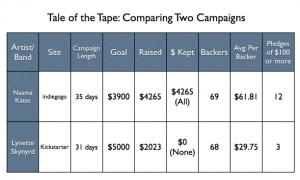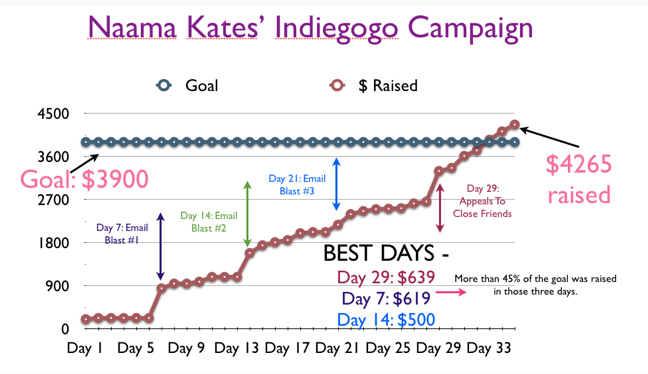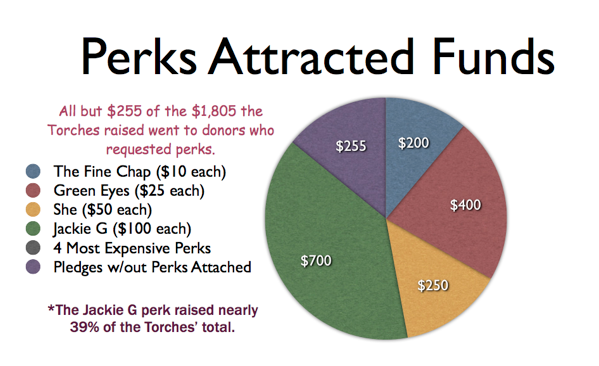LA Artists Look To Crowdfunding Sites For Help
 Crowdfunding refers to the “the collective effort of individuals who network and pool their resources, usually via the Internet, to support efforts initiated by other people or organizations,” according to research conducted by Lucia Miceli and her associates for the Journal of Service Management.
Crowdfunding refers to the “the collective effort of individuals who network and pool their resources, usually via the Internet, to support efforts initiated by other people or organizations,” according to research conducted by Lucia Miceli and her associates for the Journal of Service Management.
Kickstarter, which was launched April 28, 2009, is currently the most visited crowdfunding website and has been named by Time Magazine as one of the “Best Inventions of 2010” and “Best Websites of 2011.” Indiegogo is a popular alternative.
These websites allows campaigns of many different varieties, but music campaigns tend to be especially common.
Lynette Skynyrd, a four-woman group that claims to be the “world’s one and only all-female Lynyrd Skynyrd tribute band,” decided to launch a Kickstarter campaign in order to fund its debut album. “Lynette Skynyrd has a strong Facebook presence,” said the group’s lead singer, Laurie Es. “We get dozens of requests for recorded material (on there).”
The band launched the campaign on Nov. 8 with a goal of $5,000. As of Tuesday night, Nov. 27, only $1,651 had been pledged, approximately one-third of the goal despite the campaign being two-thirds of the way through.
“I doubt very much we will meet our goal,” said Es. “We have less than two weeks left, and we are not even halfway funded.”
Kickstarter only offers fixed funding. In other words, Es and her bandmates will not receive any of the pledged money unless the full $5,000 goal is reached. Even if $4,999 were raised, Lynette Skynyrd would receive nothing.
“I think people do not understand the all-or-nothing aspect of Kickstarter,” said Es.
“I didn’t realize that there were some that didn’t require you to reach a goal.”
Indiegogo, one of the most popular crowdfunding platforms after Kickstarter, does not require campaign starters to reach their goal in order to receive funds. Instead, Indiegogo offers a choice between fixed funding and flexible funding. Not surprisingly, the vast majority of musicians on Indiegogo opt for flexible funding.
For instance, if by the end of its campaign, Lynnette Skynyrd raised half of its goal using a flexible-funding Indiegogo campaign, the band would receive the money it raised ($2,500 in this example). On Kickstarter, however, the group would not see a dime, and all contributors would be returned their money. Contributors’ pledges are not taken out of their accounts until a project is fully funded on Kickstarter.
“I wish I had explored other crowdfunding platforms,” said Es. “We went with Kickstarter because that’s the one everyone knows. Other musicians we knew and trusted had used Kickstarter and were successful.”
Torches, a trio of Los Angeles musicians in their 20s, decided to launch their campaign on Indiegogo. With seven days remaining and only 26 percent of the goal pledged ($1,065 of $4,000), the goal appeared unattainable: “Although we could be doing a lot better, I don’t think we’ll reach our goal this time around,” said lead singer and guitarist Azad Cheikosman.
Cheikosman is not as worried as Es, because for him, there is far less urgency. First and most importantly, Cheikosman understands that by virtue of using Indiegogo’s flexible-funding option, his band will be able to keep whatever it raises, even if that amount falls short of the desired $4,000. Secondly, Torches launched a successful Indiegogo campaign in February that funded the group’s debut album, “Heads Full Of Rust.”
In contrast, Lynette Skynyrd has yet to release music and will not be receiving any of the funds pledged by its contributors if its campaign goal is not met.
Some artists, such as Los Angeles-based singer and songwriter Ari Herstand, argue that the all-or-nothing quality of Kickstarter serves as a powerful motivator for prospective contributors. As the argument goes, contributors will be more likely to pledge money if the campaign has a chance of failure.
Others disagree. Cheikosman and his bandmates chose to use Indiegogo primarily because it didn’t require the all-or-nothing aspect: “We decided to go with Indiegogo because they seemed the most fair and offered the best deal,” said Cheikosman. “You can keep everything you’ve raised regardless of whether or not you have reached your goal. I don’t think that is the case with Kickstarter.” It is not.
There are also differences in payment plans on Indiegogo and Kickstarter. If a campaign’s goal is reached on Indiegogo, the website collects a 4 percent fee. If the goal isn’t met, Indiegogo collects 9 percent. On Kickstarter, 5 percent is taken if a project’s funding is successful. If unsuccessful, Kickstarter won’t charge any money.
For Kickstarter, payment processing generally costs 3-5 percent, while Indiegogo charges 3 percent credit card processing.
Naama Kates is also using Indiegogo in an effort to fund her campaign. Kates, who was a solo artist on her first album, decided to team up with three musicians to form a quartet ensemble. Unlike most artists on Indiegogo or Kickstarter, she has already finished recording the album entitled “King for the Day.” Rather, Kates started the campaign to raise money for an ambitious, three-month P.R. campaign.
 With six days remaining of her 35-day campaign, Kates had raised nearly 80 percent of her $3,900 goal. “I still believe we should focus our energies on creating our work,” wrote Kates on her Indiegogo campaign page, “but once it’s created?” she rhetorically asked.
With six days remaining of her 35-day campaign, Kates had raised nearly 80 percent of her $3,900 goal. “I still believe we should focus our energies on creating our work,” wrote Kates on her Indiegogo campaign page, “but once it’s created?” she rhetorically asked.
“PR is a service that costs money,” said Kates. “And a lot of it. And it’s necessary if anyone is to hear about it (the album).”
Kates argued that she needed to use a crowdfunding website like Indiegogo, because she lacked the money and press connections to launch a successful PR campaign without outside help.
“I can’t do that alone or expect anyone who’s not devoted and connected to the world of the press to do (it) themselves,” said Kates.
“I also thought, well, do I know 100 people that would give 40 dollars if I asked? It’s possible. Breaking it down like that, I think, makes it simpler for people, and seem more attainable.”
Like Cheikosman, Kates was attracted to Indiegogo, because of the site’s flexible-funding option: “I chose it because you get to keep the money you make. I don’t know why anyone would choose to go the other way. I’m happy to take whatever I get.”
On Indiegogo and Kickstarter, campaign starters don’t just raise money without giving contributors something in return. Campaign starters must also determine what they will give contributors depending on how much money is pledged. Indiegogo calls them perks, whereas Kickstarter refers to these packages as pledges. Typically, each package includes all the same perks the previous packages include, plus something extra depending on how much more money is contributed.
For instance, a $100 contribution to Lynette Skynyrd’s campaign will get a contributor stickers, a poster, the album, a t-shirt and a personalized voicemail or answering machine message from the band. The group is offering a unique package for $500 contributors. For $500, Lynette Skynyrd is offering a “used and autographed bra from each member of the band.” So far, no one has taken the bait.
For $1,000, a package for which there are also no takers, the band will “record any song from the Ronnie Van Zant Skynyrd era and dedicate it to you on the album.”
“I had an innate sort of gut-feeling that it wasn’t about the perks,” said Kates. “People who want to contribute do so, not in order to get anything back (besides the minimal perk options I gave), but because they believe in you. The perks are sort of meaningless.”
Herstand, who raised $13,544 in one month on Kickstarter last January, however, paid close attention to pledge packages. “Most likely, your backers will be people you know personally or are your biggest supporters,” he said.
“You must tailor your rewards to them.
“Too many musicians create unoriginal rewards that may have been cool in the 90s if their favorite band was running this kind of thing, but today, you have to understand who you’re targeting.”
 Although Kates referred to campaign perks as “sort of meaningless,” she ultimately reached her $3,900 goal (and more), largely due to two especially successful campaign perks: “A Magic Number” ($39) and “Artist to Artist Love” ($500). A Magic Number, which was individually worth exactly 1 percent of her goal, was clearly the campaign’s most successful perk, garnering 23 pledges. That’s not surprising, as on the campaign page, Kates told prospective donors, “If 100 people each give 39 bucks, that’s 3,900 bucks! Trust me. I’m a math teacher.”
Although Kates referred to campaign perks as “sort of meaningless,” she ultimately reached her $3,900 goal (and more), largely due to two especially successful campaign perks: “A Magic Number” ($39) and “Artist to Artist Love” ($500). A Magic Number, which was individually worth exactly 1 percent of her goal, was clearly the campaign’s most successful perk, garnering 23 pledges. That’s not surprising, as on the campaign page, Kates told prospective donors, “If 100 people each give 39 bucks, that’s 3,900 bucks! Trust me. I’m a math teacher.”
The $500 perk called “Artist to Artist Love” offered everything from the first six perks, plus free SAT tutoring sessions and a special thanks on the liner notes of the new album. Two people pledged for this perk, accounting for $1,000, more than a quarter of Kates’ $3,900 goal.
By contrast, the Torches received no pledges of more than $100. Lynette Skynyrd’s campaign attracted only three donations of $100 or more despite garnering 68 backers.
Most of the Torches’ larger perks involved live performances. Either the perks were not enticing enough to draw contributors or they cost too much money. Maybe both. Lynette Skynyrd’s aforementioned bra perk similarly drew no interest.
Whether or not it was the SAT lessons or Kates’ music and overall campaign presentation, the two $500 pledges came a long way in allowing her to reach her goal. In addition to the two $500 pledges, 10 others pledged $100 or more to Kates’ campaign. Although successful campaigns have been achieved through hundreds or thousands of small donations, large contributions can definitely help. The lack of large contributions clearly hurt the campaigns of the Torches and Lynette Skynyrd.
With a week left in its campaign, the Torches did not expect to reach its $4,000 goal, “Our contributors will get the new EP whether or not we reach our goal,” assured Cheikosman. “We also have a few paid gigs before the end of the year, so that should help.”
By the end of its campaign, the Torches did not reach its goal, but as a result of the campaign’s flexible-funding approach, the band will keep all the money it raised. The group raised $1,805, which accounted for more than 45 percent of its $4,000 goal.
Similarly, Lynette Skynyrd did not reach its goal by the end of its campaign (it fell nearly $3,000 short). Unlike the Torches, however, the campaign’s fixed-funding meant the band would receive none of the $2,023 raised.
With no money gained and a large amount of time squandered, the band must now go back to the drawing board. “If we had gone with the other one (Indiegogo’s flexible-funding option), at least we would have something we could build upon,” said Es.
Originally published by VivaLAMusic.



